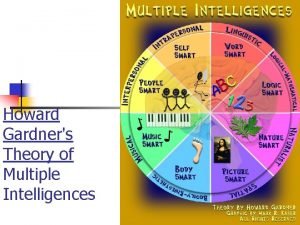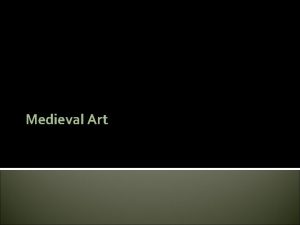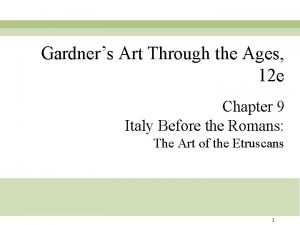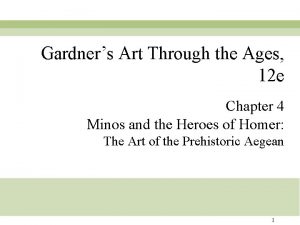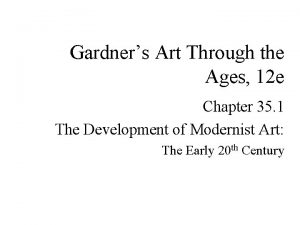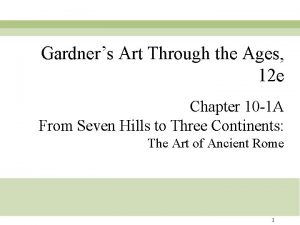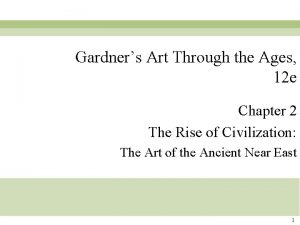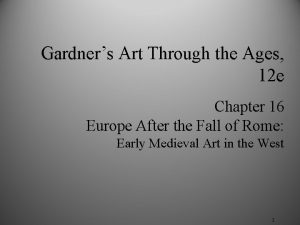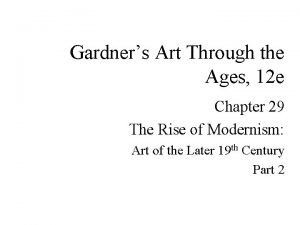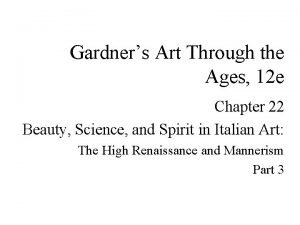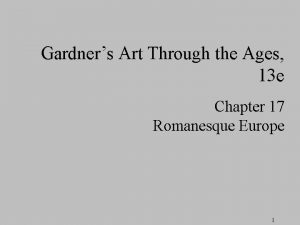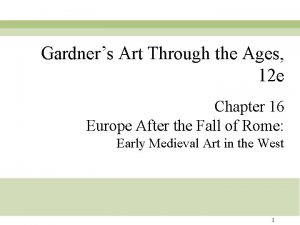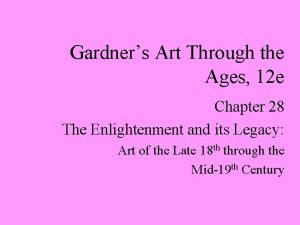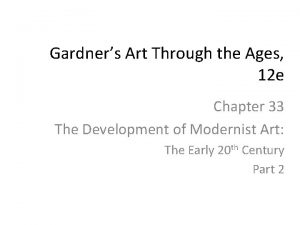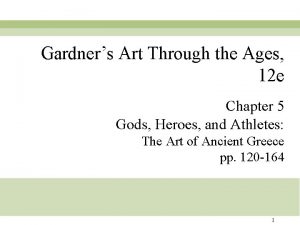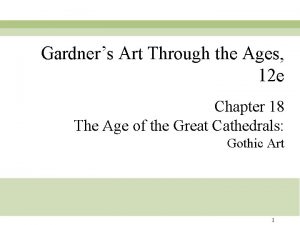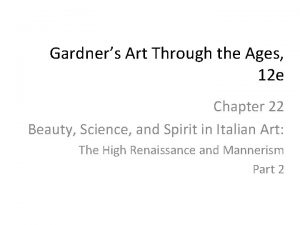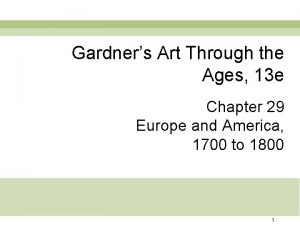Gardners Art Through the Ages 12 e Chapter


















- Slides: 18

Gardner’s Art Through the Ages, 12 e Chapter 22 Beauty, Science, and Spirit in Italian Art: The High Renaissance and Mannerism Part 3

Venice During the Renaissance

16 th Century Venetian Art and Architecture • The commercial and political power enjoyed by Venice during the 15 th century declined in the 16 th century due largely to the discoveries in the New World and the economic shift from Italy to Hapsburg Germany and the Netherlands. Moreover, since the Turkish conquest of Constantinople, Venice had lost control of the eastern Mediterranean. Venice remained independent despite attacks by the League of Cambrai, composed of Spain, France, the Holy Roman Empire, and the Papal States. • Giovanni Bellini's monumental sacra conversazione (holy conversation) altarpiece in San Zaccaria, Venice, shows the Virgin enthroned with the Christ Child in the company of four saints. The figures are bathed in an evocative, soft-colored light. The harmonious, balanced presentation of luminous colors results in an image that gently radiates a feeling of serenity and spiritual calm.

GIOVANNI BELLINI, San Zaccaria Altarpiece, San Zaccaria, Venice, Italy, 1505. Oil on wood transferred to canvas, approx. 16’ 5” x 7’ 9”.

Bellini and Titian • Giovanni Bellini is often seen as the father of the Venetian school of the Italian Renaissance of the 16 th-century, but his student Titian would become the leader. He was recognized by his contemporaries as "The Sun Amidst Small Stars. " • Giovanni Bellini's Feast of the Gods (derived from Ovid's Fasti ) is a new kind of mythological painting that shows the Olympian gods as peasants enjoying a picnic in a shady, rural place of rustic peace and simplicity. Bellini and other Venetian artists focused on color and the process of paint application, whereas Florentine and Roman artists were more concerned with sculpturesque form, drawing, and design (disegno). Venetian artists developed a "poetic, " lyrical, and sensual art, whereas artists in Florence and Rome gravitated toward grand, heroic, esoteric, and intellectual themes.

GIOVANNI BELLINI and TITIAN, The Feast of the Gods, 1529. Oil on canvas, approx. 5’ 7” x 6’ 2”.

Giorgione • A student of Bellini and a close associate of Titian, Giorgione died young and six of his paintings are known to survive. • As well as painting altarpieces and portraits, Giorgione painted pictures that told no story, whether biblical or classical, or if they professed to tell a story, neglected the action and simply embodied in form and color moods of lyrical or romantic feeling, much as a musician might embody them in sounds. • Giorgione's so-called Pastoral Symphony, which shows two voluptuous nude females accompanied by two clothed young men in a landscape with a shepherd, exemplifies the Venetian poetic manner in its eloquent though enigmatic evocation of a dreamy, tranquil, pastoral mood. • Giorgione's enigmatic painting The Tempest shows a lush landscape with human figures in the foreground threatened by stormy skies and lightning.

GIORGIONE DA CASTELFRANCO (and/or TITIAN? ), Pastoral Symphony, ca. 1508. Oil on canvas

GIORGIONE DA CASTELFRANCO , The Tempest, ca. 1510. Oil on canvas, 2’ 7” x 2’ 4 3/4”. Galleria dell’Accademia, Venice.

Titian: the Master • During the course of his long life Titian's artistic manner changed drastically but he retained a lifelong interest in color. Although his mature works may not contain the vivid, luminous tints of his early pieces, their loose brushwork and subtlety of polychromatic modulations are without precedent in the history of Western art. • Titian's Madonna of the Pesaro Family in the church of the Frari, Venice, shows Pesaro, bishop of Paphos in Cyprus and commander of the papal fleet, who had led a successful expedition in 1502 against the Turks during the Venetian-Turkish war, being received by the Madonna together with saints and a Turkish prisoner of war. The monumental figures are placed on a steep diagonal with the Madonna at the apex off to the right. • Titian's Meeting of Bacchus and Ariadne shows Bacchus, accompanied by his boisterous and noisy retinue, arriving to save Ariadne, who had been abandoned by Theseus on the island of Naxos. The rich, luminous colors add to the painting's sensuous appeal.

TITIAN, Assumption of the Virgin, Santa Maria Gloriosa dei Frari, Venice, Italy, ca. 1516– 1518. Oil on wood, 22’ 6” x 11’ 10”.

TITIAN, Madonna of the Pesaro Family, Santa Maria dei Frari, Venice, Italy, 1519 – 1526. Oil on canvas, approx. 16’ x 9’.

TITIAN, Meeting of Bacchus and Ariadne, 1522– 1523. Oil on canvas, 5’

The Venus of Urbino • In The Venus of Urbino, Titian has domesticated Venus by moving her to an indoor setting, engaging her with the viewer, and making her sensuality explicit. Devoid as it is of any classical or allegorical trappings -Venus displays none of the attributes of the goddess she is supposed to represent- the painting is unapologetically erotic. • The frankness of Venus's expression is often noted; she stares straight at the viewer, unconcerned with her nudity. In her right hand she holds a posy of roses whilst her left covers her groin, provocatively placed in the centre of the composition. • However, this painting is typically interpreted as an allegory of marital love. Lying next to her is her pet dog, a symbol of faithfulness which could be related to the bond of marital love. In the window is a pot of myrtle: a symbol of constancy.

TITIAN, Venus of Urbino, 1538. Oil on canvas, approx. 4’ x 5’ 6”. Galleria degli Uffizi, Florence.

Figure 22 -38 Detail Reclining Venus © 2005 Saskia Cultural Documentation, Ltd.

Women in the Renaissance Art World • Though the number of women artists was limited, some women (especially Isabella d’Este) played a role as major art patrons. • Titian's portrait of a poised and self-assured Isabella d'Este is a psychological reading of the body's most expressive parts--the head and the hands.

TITIAN, Isabella d’Este, 1534– 1536. Oil on canvas, 3’ 4 1/8” x 2’ 1 3/16”. Kunsthistorisches Museum, Vienna.
 Howard gardners theory of multiple intelligences
Howard gardners theory of multiple intelligences Multiple intelligences test
Multiple intelligences test Dark ages def
Dark ages def Renaissance vs medieval art
Renaissance vs medieval art Chapter 7 early childhood ages 3 through 5 answer key
Chapter 7 early childhood ages 3 through 5 answer key A pattern repeated through the ages in literature
A pattern repeated through the ages in literature Technology through the ages
Technology through the ages Art of emerging europe meaning
Art of emerging europe meaning Characteristic of medieval art
Characteristic of medieval art Lesson 4 the late middle ages
Lesson 4 the late middle ages Medieval hierarchy
Medieval hierarchy Through one man sin entered the world, and through one man
Through one man sin entered the world, and through one man Dome of furcation
Dome of furcation Through and through sawing advantages
Through and through sawing advantages Night of the scorpion by nissim ezekiel summary
Night of the scorpion by nissim ezekiel summary Hình ảnh bộ gõ cơ thể búng tay
Hình ảnh bộ gõ cơ thể búng tay Frameset trong html5
Frameset trong html5 Bổ thể
Bổ thể Tỉ lệ cơ thể trẻ em
Tỉ lệ cơ thể trẻ em

